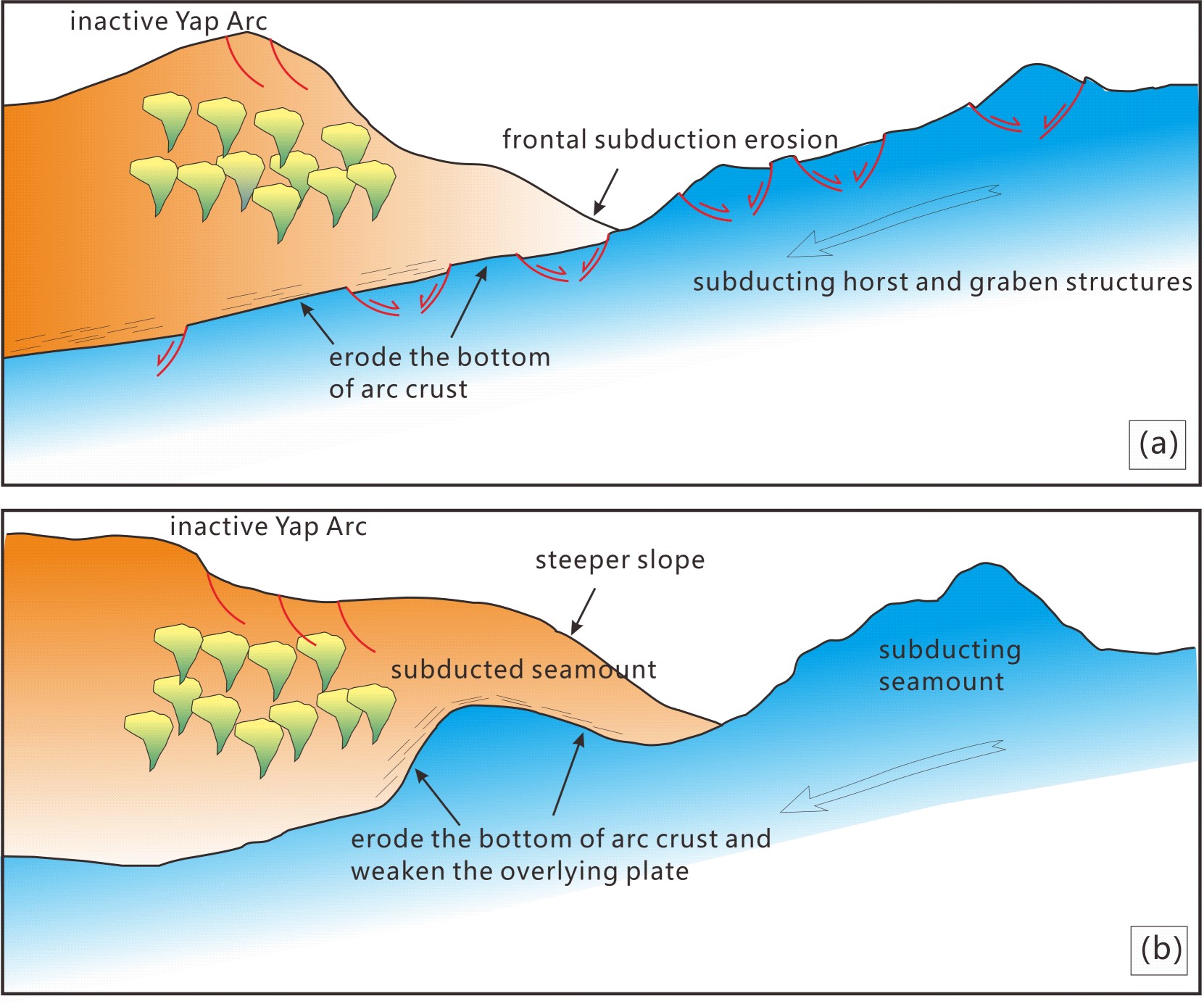New breakthroughs in the evolution of the Yap subduction zone, west Pacific
Recently, Geochemistry, Geophysics, Geosystems and Tectonophysics publish online the latest research on tectonic evolution in the Yap subduction zone, west Pacific, accomplished by scientists from Institute of Oceanology, Chinese Academy of Sciences. Marine tectonics and geophysics group investigates the topographic and crustal structure of the Yap subduction zone, combining multichannel seismic interpretation and crustal structure modeling, based on the comprehensive geophysical data collected by the research vessel “Kexue”. Initially, the research proposes the subduction erosion model and integrated evolution model for the Yap subduction zone since the Cenozoic.
The study reveals that, landslide developed at the upper slope break of the Yap forearc at ~ 4000 m water depth, and the slope break is clearly identified as the upper limit of a landslide body, which, however, was identified as a fault notch denoting a lithological boundary in the previous work. The result challenges the previous knowledge, and gives a new explanation, which is of great significance to establish the evolution model of the Yap subduction process (Dong* et al., 2018). In addition, the swath bathymetry and seismic profiles reveal detailed horst and graben structures, including a crescent-shaped fault zone near the contact between the Yap Trench and the Caroline Ridge, induced by bending-related extension on the subducting plate. Modified evolutionary model for the Yap subduction zone is finally proposed based on the work.

Fig 1 Submarine landslides can be identified in the slope break in the forearc of the Yap subduction zone
Seismic reflection profiles show that sediment is rare across the Yap subduction zone, especially in the trench axis. It is obvious that the subduction of the Caroline Ridge has profoundly affected the topography and sedimentary features during the subduction process zone, and led to the subduction erosion. Significantly, subduction erosion is a process which removes crustal material from the forearc wedge or the overlying plate, and then recycles the material back into the mantle during subduction. Erosive margins generally show a high convergence rate (>60 mm/yr), however, the Yap subduction zone possesses an extremely slow convergence rate (3-6 mm/yr) although it presents typical features of an erosive margin, such as anomalous arc-trench distance (~40 km), steep forearc slope and rare sediment in the trench, which makes the Yap subduction zone a distinctive erosive margin. The group investigates subduction erosion model at the Yap subduction zone initially. The investigation reveals that the high relief on the subducting plate with normal faults and seamounts led to the erosion of the overlying plate, and that different subduction processes, controlled locally by the topography of the subducting plate, have modified the Yap subduction zone. In addition, the normal faulting zone on the subducted crust might have eroded the forearc crust, and subsequently eroded the Yap arc crust during the subduction. The subduction erosion at the Yap Trench provides one of the best cases of erosive margins in the world, particularly for a subduction zone with an extremely slow convergence rate (Zhang, Dong* et al., 2018).

Fig 2 Subduction erosion model of the Yap subduction zone in the northern segment.
(a) The subduction of horst and graben structures or (b) seamounts eroded the overriding plate and thinned the arc crust.
These researches are supported by the Strategic Priority Research Program of the Chinese Academy of Sciences (No. XDA11030102), RV KEXUE Advanced User Program (No. KEXUE2018G10) and so on. The Corresponding and first authors of these papers are associate professor, Dongdong Dong and doctoral candidate, Zhengyi Zhang, respectively.
References:
Dong, D., Zhang, Z., Bai, Y., Fan, J., & Zhang, G. (2018). Topographic and sedimentary features in the yap subduction zone and their implications for the caroline ridge subduction. Tectonophysics, 722, 410-421.link:https://www.sciencedirect.com/science/article/pii/S0040195117304924
Zhang Z., Dong D.*, Sun W., Wu S., Bai Y., Wang X. & Fan J. (2018). Subduction erosion, crustal structure and evolution model for the northern Yap subduction zone: new observations from the latest geophysical survey. Geochemistry, Geophysics, Geosystems, doi: 10.1029/2018GC007751
link:https://doi.org/10.1029/2018GC007751